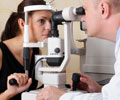Specialty contact lenses developed by scientists offer cure for myopia (nearsightedness).

The peripheral farsightedness may worsen myopia because as children grow, the eye grows to move the retina to where the light is focused, naturally lengthening the eye even further.
Troilo and his colleagues have shown that specially designed contact lenses that alter how light is focused in the peripheral retina can induce changes in growth that help reshape the eye in the desired way.
The experimental lenses use different focal powers within a single lens: either alternating focal powers across the lens, or confined to the outer edge. Experiments with the new lenses found that they changed eye growth and refractive state, or focus, in a predictable way. The lenses successfully reduced the elongation of the eye that causes myopia progression.
Several contact lens designs may soon be available to help eye doctors manage the progression of myopia in children, Troilo said.
Troilo will describe his findings at the Optical Society's (OSA) Annual Meeting, Frontiers in Optics (FiO) 2012, taking place Oct. 14 in Rochester, N.Y.
Advertisement












